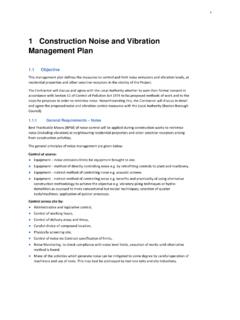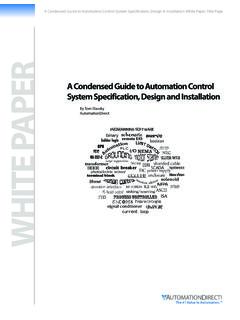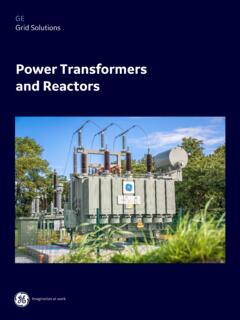Transcription of Basic Electricity Safety - Occupational Safety and Health ...
1 1 Train-the-Trainer: Basic Electricity Safety This material was produced under a Susan Harwood Training Grant #SH-24896-SH3 from the Occupational Safety and Health Administration, Department of Labor. It does not necessarily reflect the views or policies of the U. S. Department of Labor, nor does mention of trade names, commercial products, or organizations imply endorsement by the U. S. Government. The Government does not warrant or assume any legal liability or responsibility for the accuracy, completeness, or usefulness of any information, apparatus, product, or process disclosed. Objectives: To acquire Basic knowledge about Electricity , hazards associated withelectric shock and means of prevention. To understand how severe electric shock is in the human body. To develop good habits when working around Electricity . To recognize the hazards associated with the different types of power toolsand the Safety precautions necessary to prevent those 1: The Electric Shock (Ice Breaker) 1.
2 Ask participants to form a circle and then ask a volunteer to leave the Once the volunteer has left the room, explain to the participants that one of themwill carry electric current but that no one should say anything. There will bepaper pieces in a hat and the first person that picks a red colored piece of paper willcarry the electric should all remain silent, except when the volunteer guesses who carries the electric current. Once the volunteer has touched the shoulder of the person with the electric current, all of the participants should scream and make noise. 3. Call the volunteer to come in and let him/her know that one of the participantsfrom the circle has electric current and that he needs to guess who it is by goingaround the circle and tapping them on the There will be a list of questions that participants must answer. If the volunteerguesses who the person with the electric current is within the first three tries, thenthe person with the current must answer the question.
3 If the volunteer does notguess whom the person with the electric current is, then he/she must answer The person that carried the electric current will be the next one to go outside toguess who the next person with the current is. This will go on until we have asked 8questions about Electricity and the use of power : This activity will serve as an icebreaker and a pre-test. 2 Activity 2: Introduction to Electricity Start by asking participants to raise their hand if they ever come in contact with Electricity at their jobs. Electricity has become essential to modern life because of how practical and useful it is. Much of our daily work relies on Electricity , whether at an office, retail, restaurant, construction site or any other industry and perhaps because it is so familiar to us, that oftentimes we tend to overlook the hazards associated with this source of energy. A lot of workers are killed or injured by Electricity every year.
4 It may be because of a lack of understanding of how Electricity works or not being careful when working with Electricity . Understanding the dangers of Electricity , how to respond in an emergency and proper Safety procedures will go a long way in preventing injury or death caused by this powerful force. This workshop will describe how Electricity works, identifying the hazards and injuries associated with Electricity , general precautions and tips to be safe, controlling hazards, and first aid advice. We will also cover how to use different power tools in a safely manner. Here are some definitions you should know: Current is the flow of Electricity . Voltage is the measurement of electric potential. A Circuit is a network consisting of a closed loop, giving a return path for the current. Alternating Current is the form in which electric power is delivered to businesses and residences.
5 (such as the power from your wall outlet). Direct Current the flow of electric charge is only in one direction (such as from a battery). Conductor is an object or type of material that allows the flow of Electricity . Resistance is the capacity of a material to lower or stop electric current. Activity 3: Let s generate some energy! Note to facilitators: You can use a potato clock kit or you can make your own. What you will need: A knife A potato 2 pennies 2 zinc-galvanized nails Copper wire A small light bulb or a small clock 3 Information to protect workers Share the following information with participants. Using pictures of PPE and circuit protection devices, show participants what the proper equipment is to protect themselves when working with or near electric power. What are circuit protection devices and how do they work? Circuit protection devices limit or stop the flow of current automatically in the event of a ground fault, overload, or short circuit in the wiring system.
6 Well-known examples of these devices are fuses, circuit breakers, ground-fault circuit interrupters, and arc-fault circuit interrupters. Fuses and circuit breakers open or break the circuit automatically when too much current flows through them. When that happens, fuses melt and circuit breakers trip the circuit open. Fuses and circuit breakers are designed to protect conductors and equipment. They prevent wires and other components from overheating and open the circuit when there is a risk of a ground fault. Ground-fault circuit interrupters, or GFCIs, are used in wet locations, construction sites, and other high-risk areas. These devices interrupt the flow of Electricity within as little as 1/40 of a second to prevent electrocution. GFCIs compare the amount of current going into electric equipment with the amount of current returning from it along the circuit conductors. If the difference exceeds 5 milliamps, the device automatically shuts off the electric power.
7 Arc-fault devices provide protection from the effects of arc-faults by recognizing characteristics unique to arcing and by functioning to de-energize the circuit when an arc-fault is detected. Another form of protection is to use listed or labeled portable tools and appliances protected by an approved system of double insulation or its equivalent. Where such a system is employed, it must be marked distinctively to indicate that the tool or appliance uses an approved double insulation system. Here are other ways to protect yourself: Use Ground Fault Circuit Interrupters (GFCIs) to help protect people from electrical shock in homes, offices, hospitals, schools, worksites, and outdoors. GFCIs meet the latest NEC and UL requirements. Wear voltage rated rubber gloves Use rubber boots for damp locations. Wear a hat or cap. Wear an approved Safety helmet (hard hat) if the job requires.
8 4 Confine long hair or keep hair trimmed and avoid placing the head in close proximity to rotating machinery. Do not wear jewelry. Gold and silver are excellent conductors of Electricity . Make sure the space is cool enough to avoid excessive sweating. What you need to do: 1. Cut the potato in half with the knife to expose the interior. Use the knife to cut a penny-sized slit in the middle of the potato half. 2. Wrap a piece of copper wire around each penny. Press the wire-wrapped pennies into the slits created in each of the potato halves. Leave some of the wire hanging out of the potato. 3. Slide one nail into the end of each potato half. Wind copper wire around each nail. 4. Attach the loose copper wire from a penny to the copper wire on the nail attached to the opposite potato. Do not connect the nail and penny wires in the same potato. 5. Connect the two loose wires from the remaining penny and nail, to the light bulb.
9 When the wires touch the bulb, it lights up. Here are some things that might be helpful when conducting this test: If the nail and a penny touch, the experiment will not work. Peeling the potato or soaking it in Gatorade sometimes helps conduct the Electricity . Use caution with the wires once it becomes an electric conduit. Once the closed circuit is created, ask a volunteer to open the circuit through one of the cables and one of the metal parts. Then ask the participant to hold the cable with one of his/her hands and hold the metal piece with the other hand. The clock should turn on again, making the participant part of the closed circuit. Then explain to participants that they became part of the closed circuit and that if the voltage was any higher, they could potentially get hurt or shocked. After the experiment with the potato, ask participants to describe in their own words how Electricity works.
10 Make sure to emphasize the importance of understanding that when a closed circuit is interrupted, Electricity will look for the closest path or conductor to the ground. What does this exercise teach us about Electricity ? NOTE: Because the voltage that the potatoes generate is very low (less than 1 milliamp), the participants DO NOT run the risk of getting hurt or shocked. How Does Electricity Work? Ask participants: Can anyone tell me why birds that sit on electrical post wires do not get electrocuted? Give room for possible answers. Basically, a circuit consists of three essential elements: 1) the source of energy, which supplies the driving force or voltage to make the current flow; 2) the user of 5 Electricity , for example a light bulb or a clock; and 3) transmission lines or wires to conduct the Electricity . For current to flow there must be a complete or closed circuit. If a wire is cut or disconnected somewhere forming an open circuit, charges will accumulate and stop the flow of current.















![J1. Definitions [rps/rcp/rp/dp] - Auckland Council](/cache/preview/d/d/2/a/0/8/d/0/thumb-dd2a08d06e371f3ed80cf4e9fa2dd563.jpg)